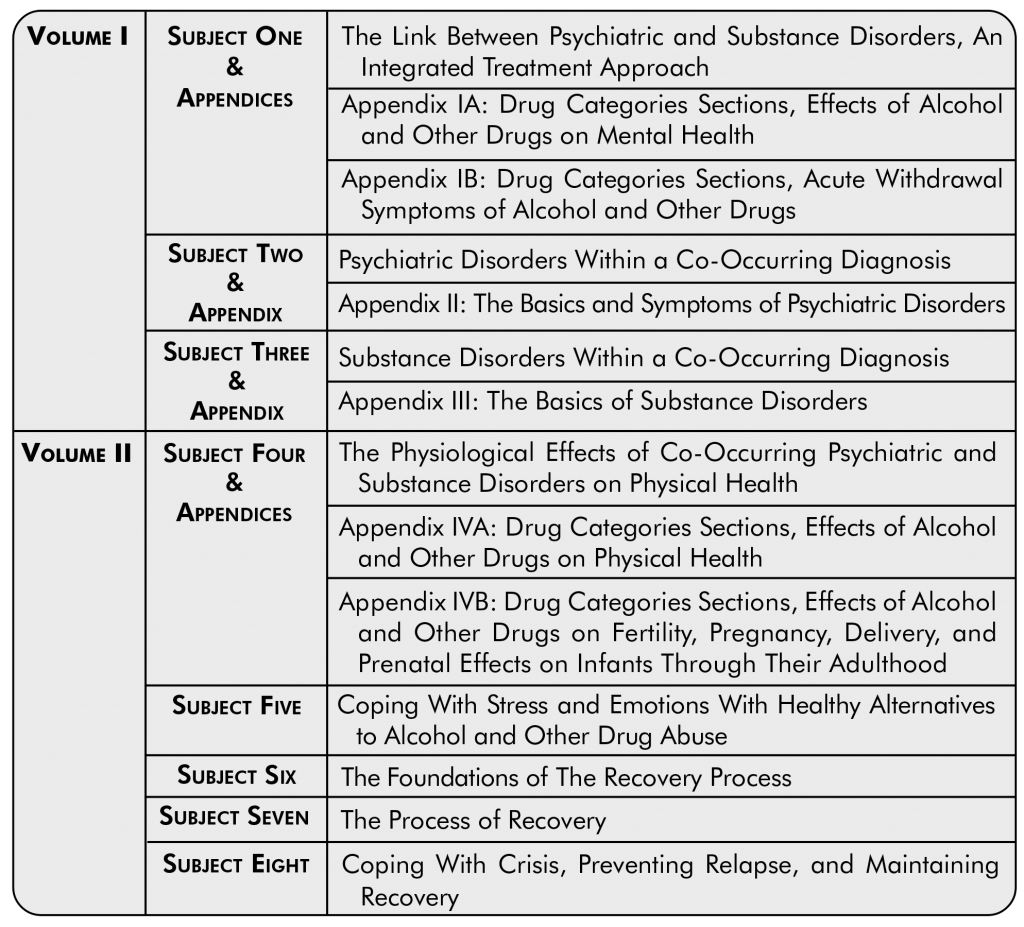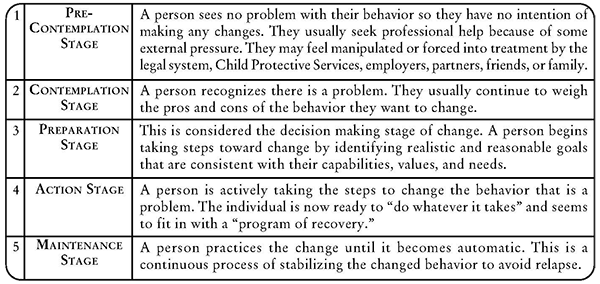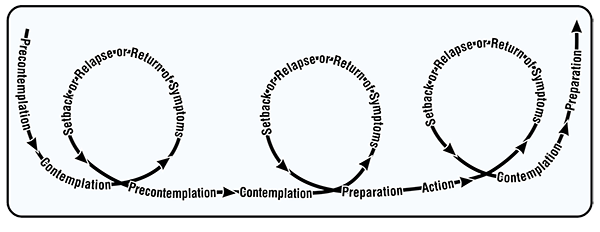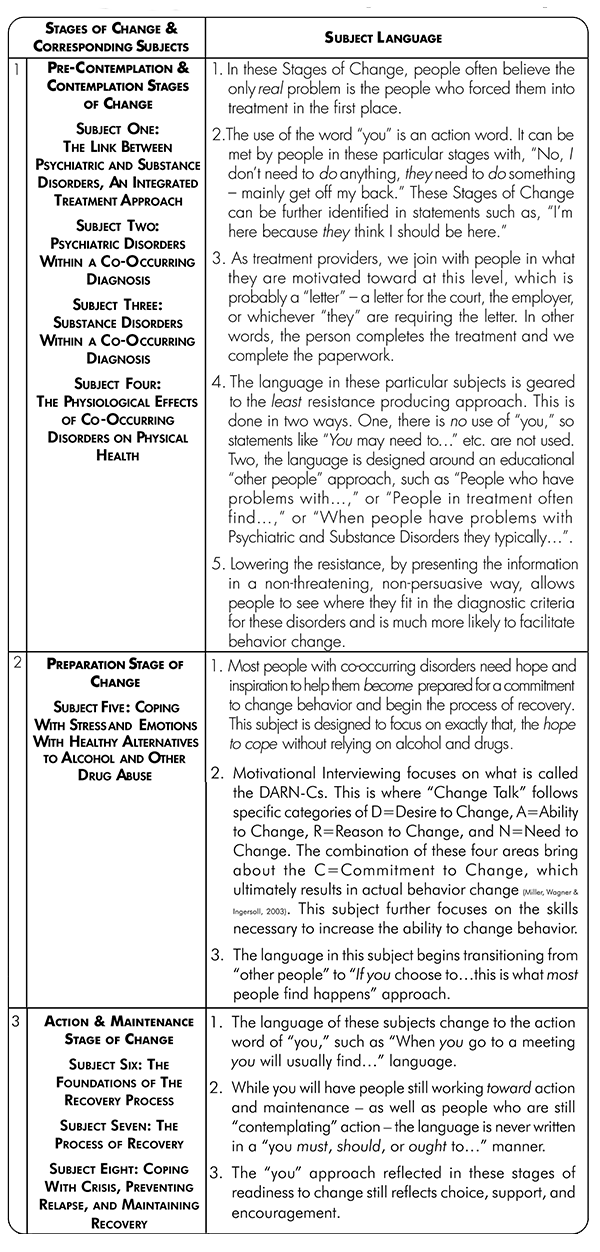Stages of Change
The following pages include the topics:
Change is rarely something a person does willingly. It’s human nature that doing things in a certain way becomes comfortable. A person tends to choose the familiar over the unfamiliar or the known over the unknown. Even when a person is doing things that aren’t healthy, they are at least familiar. (excerpt from THE BASICS, Second Edition)
Yet, change is a part of life and is constant. Only the rate and kind of change varies. In other words, with or without recovery there will be change. Without recovery, change will be a spiraling downward journey as the symptoms and the severity of a disorder worsens over time. This is the same process for al chronic disorders like heart disease, diabetes, high blood pressure, etc. With recovery, change takes place as a result of improved functioning through the reduction of problems and symptoms. The changes toward recovery result in a spiraling upward journey into health. (excerpt from THE BASICS, Second Edition)
Change also doesn’t happen without a person’s involvement. In other words, change doesn’t happen to a person. It happens because of the efforts a person makes. There’s a saying, “If nothing changes, nothing changes.” Another one is, “If you always do what you’ve always done then you’ll always get what you’ve always gotten and you’ll always be where you’ve always been.” Change begins to take place little by little, day by day, one day at a time, one step at a time. (excerpt from THE BASICS, Second Edition)
All individuals have a fundamental potential or ability to change (Advocates for Human Potential, 1997). Studies have found that individuals who modify their behavior have a great deal in common in the way these changes take place. In other words, they proceed through certain stages of change. This means that a person is in various “stages of readiness” for change (Prochaska, Norcross & DiClemente, 1994). It’s helpful for each person to learn about the stages that take place in changing behaviors (DiClemente, 2002). (excerpt from THE BASICS, Second Edition)
Volume I and II
To understand how THE BASICS, Second Edition is written to incorporate the Stages of Change let’s review how the curriculum is organized into Subjects and Appendices:

Individual Descriptions of the Stages of Change
Research found that people proceed through what is called “Stages of Change” (Prochaska, Norcross & DiClemente,1994). Characteristics of each of the stages of change was further expanded by the founders of Motivational Interviewing – William Miller and Stephen Rollnick – and is a way to identify a person’s “stage of readiness” for change.
The similar way that each person changes behaviors are identified by these specific definitions and specific characteristics:

The Spiraling Pattern of Change
A person doesn’t usually go straight from one stage of change to another. Change is made in steps: one step forward and two steps back, then three steps forward, and one back. Ideally, with time the number of steps forward is greater than the number of steps backward.
Changing behaviors takes time and often includes setbacks or relapses. Change may take place in any number of combinations. A person may go from the Pre-Contemplation Stage to Contemplation to Preparation to Action and back to Preparation again in a spiraling pattern of change (Prochaska, et al., 1994): (excerpt from THE BASICS, Second Edition)

Different Stages of Change at The Same Time
People certainly don’t progress through the Stages of Change in the time it takes to work through this curriculum – or even attend a treatment program for that matter – since each stage can take months or even years to complete.
You will have people in your group with the same Psychiatric or Substance Disorders who will be at different levels of readiness to change one or more behaviors. Even the same person can be in different stages of change for different behaviors.
Let’s review how people can be in different stages of readiness for change for different behaviors at the same time:
- A person may be in the Action Stage of Change regarding cocaine abuse by breaking all contact with friends and dealers.
- The individual may be in the Pre-Contemplation Stage of Change regarding alcohol abuse by thinking there is no problem with their alcohol use and no need to make changes.
- They can also be in the Contemplation Stage of Change regarding a Psychiatric Disorder, such as Major Depression by weighing the pros and cons of seeing a mental health professional or taking medication.
The possible scenarios are only limited by the number of people you have in your group and by how many disorders or behavior change goals each person has!
Each behavior change has a separate stage of change even within the same diagnosis. For example:
- A person may be in the Action Stage of the importance of attending Twelve Step meetings and taking action by attending the meetings.
- They can also be in the Contemplation Stage as they continue to weigh the pros and cons about the need of getting a sponsor.
- A person may even return to the Pre-Contemplation Stage of deciding there is no need to get a sponsor.
- Perhaps they may relapse which is a setback and then possibly return to Contemplation by weighing the pros and cons of having a sponsor. The individual may even perhaps move to Action by getting a sponsor or stay in Contemplation.
Subjects Incorporate the Stages of Change
The Stages of Change Model has been known and increasingly understood for almost three decades. The biggest question seems to be whether or not we actually personalize our treatment approach, therapeutic goals, and program content to match the stages of change for each person and the behavior change they are working toward.
For instance, do we recognize that a person is in the Pre-Contemplation Stage of Change (perhaps having no real intention of changing behavior and only focused on getting their court requirement completed – which is an important goal)? Or do we continue to provide treatment that assumes they are in the Action Stage of Change just because they are actually in treatment?
I had the great pleasure of meeting with Mary Woods and her staff (Previous President of NAADAC; Chief Executive Officer at Westbridge Community Services, Manchester, New Hampshire). Mary commented, “We realize all our residents actually present in the Pre-Contemplation, Contemplation, or Preparation stages of change…because if they were in the “Action stage” they would be in an apartment and not here.” How true that is!
The subjects of the curriculum follow the Stages of Change Model (Prochaska, DiClemente & Norcross, 1992) in the following way:
Organization of the Curriculum by Stages of Change
It’s important to organize the subjects of the curriculum so they correspond to the Stages of Change:
SUBJECT ONE: The Link Between Psychiatric and Substance Disorders, An Integrated Treatment Approach
SUBJECT TWO: Psychiatric Disorders Within a Co-Occurring Diagnosis
SUBJECT THREE: Substance Disorders Within a Co-Occurring Diagnosis
SUBJECT FOUR: Physiological Effects of Psychiatric and Substance Disorders on Physical Health
SUBJECT FIVE: Coping With Stress and Emotions With Healthy Alternatives to Alcohol and Other Drug Abuse
SUBJECT SIX: The Foundations of The Recovery Process
SUBJECT SEVEN: The Process of Recovery
SUBJECT EIGHT: Coping With Crisis, Preventing Relapse, and Maintaining Recovery
This provides a foundation of program development that’s consistent with the way people progress through stages when changing a behavior. It also provides you with specific points of reference to identify the Stages of Change of each group and treatment participant. This knowledge will guide your individualized responses to specific group members, as well as provide the basis of their individualized treatment planning.
Remember, our job is to help people work through their treatment goals – not identify people as unmotivated because they are not working toward our treatment goals for them.
It is also inconsistent to have a treatment philosophy of supporting a person’s self-efficacy (sense of capability to master challenges and achieve goals) and at the same time treat the person as if they have no say or understanding of what they need.
For instance, throughout any given treatment experience, some people will remain in one Stage of Change (for instance, the Contemplation Stage of Change) during one treatment experience for either one behavior change or more or even all behavior changes regarding their Psychiatric or Substance Use Disorders.
By accurately matching each person’s level of readiness for change and supporting their self-efficacy or as we often say “meet them where they are”…each person is much more likely to move to the next stage of readiness to change. For instance, in Pre-Contemplation a person may simply want to complete treatment to make “them” happy, such as the legal system, a domestic partner, employer, CPS, etc.
Mismatching the level of readiness for change, such as trying to push a “pre-contemplator” into an “action taker,” can produce a sense of hopelessness for the “treated” and the “treater.” It also makes a person much less likely to move ahead in the stages of behavior change. Accurately matching the level of readiness makes change much more likely.
For example, for individuals who are wanting to finish treatment to regain custody of their children or meet court requirements we might say… “What will the court need for you to accomplish the goal you have of regaining custody of your children. What would the report to the court need to say?” Participants will actually write their own treatment goals like “I have to finish treatment, I need to participate in group, I need to attend Twelve Step Meetings, and I have to pass my drug tests.” Now, as a treatment provider, I have just learned what the individual needs to accomplish and am there to help them meet their goals along the way.
Subject Language Matches Stages of Change
The language of the curriculum is also consistent with the Stages of Change in the following ways:
The subjects of the curriculum follow the Stages of Change Model and match the words or phrases recommended in the stages of change (Prochaska, DiClemente & Norcross. 1992. In Search of How People Change. American Psychologist, September l992) in the following way: Excerpt from THE BASICS, Second Edition.

Recommendation Example: “THE BASICS has been a core reference and guide for many agencies attempting to integrate treatment for co-occurring disorders in Oklahoma. Their copies are invariably well worn, marked with sticky notes and highlighted throughout, reflecting its value and the frequency with which it is used.” L.D. Barney (Co-Occurring Program Specialist, (ODMHSAS) Oklahoma Department of Mental Health and Substance Abuse Services)
Open or Closed Group Psychoeducational Groups
The first Curriculum Lesson Division covered the content from the beginning to the end of the curriculum. This curriculum and topic division shown below is not related to the Lesson Plans that are in one of the major menu headings. In that section you will find examples of programs I developed, along with the lesson plans, to meet the specific needs of other treatment agencies and facilities.
To view the curriculum division developed to present content from the beginning of Subject One through Subject Eight then click the title below to see the entire content:
Identifying Stage of Change When We Actively Listen
We actually don’t even have to guess at the Stage of Change for each behavior. When we are actively listening; the person will tell us their individual level of readiness for change by what they say. For instance:
Stages of Change
Common Comments Made During Specific Stages of Change
Understanding the Stages of Change also alters how the professional “hears” the person. Professionals are encouraged to listen for change talk. How a person talks about the behavior change actually tells us what stage of change they are currently in.
This knowledge guides the professional in their individualized responses to specific group members, as well as providing the basis of their individualized treatment planning. While this may sound complicated, it can become automatic with practice.
When I hear a person say, “I don’t need to be here, the only problem is the court system!” With practice, I hear pre-contemplation and could respond to that particular person with something similar to: “Must be difficult to have to be in treatment when you don’t feel it’s fair. Continuing to come to group is really amazing because that is a great goal. What keeps you coming to group when it seems so unfair?” Because it really is.
When I hear “Being made to come to treatment is really interfering with my life even though I am learning things each week” sounds like Contemplation. I might respond “Sounds tough being “made” to come to treatment instead of being able to make your own choice, and at the same time you are seeing some benefits of being here?”
If I mismatch the stage of change…they will elaborate and tell me what it is like for them. Encouraging a person to tell their story and experiences is, after all, what we are wanting.
Elicit The Person’s Viewpoint of Their Readiness
The curriculum SUBJECTS are first written and worded directly to the treatment participant, then second the professional is simultaneously cross-trained in providing psychoeducational content as the facilitator presents the curriculum.
The curriculum contains different psychoeducation sections designed to educate group members about the Stages of Change. To achieve the goal of individuals determining their own level of readiness for change there are exercises and worksheets interwoven throughout the curriculum and especially through the individual Lesson Plans.
Education, worksheets, and exercises provide ways for participants to identify their own readiness to change at different points in treatment one day at a time and one step at a time and one stage at a time. A few examples include:
- Working Through Ambivalence Exercise;
- Weighing the Pros and Cons of Behavior Change Worksheet;
- Readiness Ruler Worksheet;
- Weighing the ‘I Want To’ and the “I Don’t Want to”
Recognizing ambivalence supports self-efficacy (one’s belief in their own ability to succeed in specific situations or accomplish a task) – an important ingredient in creating an atmosphere where change is possible. These are skills that can be practice in group and used outside of treatment and throughout recovery.
Stages of Change for Treatment Providers
Therapists, counselors, case managers, and group facilitators are human beings before they are service providers. It’s human nature for us to have our own set of treatment preferences, beliefs, values, and biases. We often have preconceived ideas about the “other” field whether it is addiction or mental health. Acknowledging biases is a good way to develop the open-mindedness necessary in learning and especially implementing any new treatment approach.
The Stages of Change applies to all behavior change – for us too. The individuals we are working with that have co-occurring psychiatric and substance disorders are being faced with changing everything about how they think, feel, act, and behave.
Most of us have been trained either as a Chemical Dependency Professional or a Mental Health Professional. In continuing to develop a more comprehensive integrated treatment approach we are also being asked to make some changes. Perhaps even being challenged on some of our beliefs, preferences, values, and perhaps biases.
It often takes time to identify our beliefs, modify them, and/or adopt new treatment approaches. This may apply to the issues of medication, twelve step programs, spirituality, or harm reduction…just to name a few possibilities. Looking at our own resistance to the change process can be enlightening as to just how difficult change can be for the individuals we are providing services to:
Stages of Change
Typical Comments Made During Specific Stages of Change
IF any of these sound even a little familiar…what is your current level of readiness for change into a more fully integrated system approach by implementing the Stages of Change more fully into your treatment approach? Where will you begin or what will you change first?